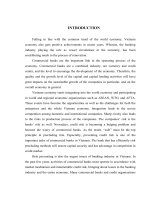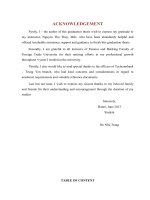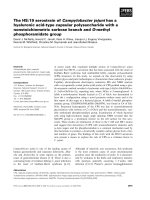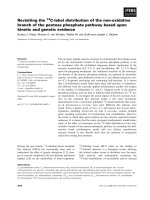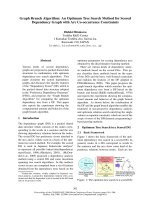Solutions to enhancing the efficiency of capital mobilization at sai gon thuong tin commercial joint stock bank thu do branch
Bạn đang xem bản rút gọn của tài liệu. Xem và tải ngay bản đầy đủ của tài liệu tại đây (397.19 KB, 85 trang )
GRADUATION THESIS
DECLARATION
I would like to assure you that the research topic “Solutions to enhancing the efficiency
of capital mobilization at Sai Gon Thuong Tin Commercial Joint Stock Bank
(Sacombank) - Thu Do Branch” was learnt about and studied after the internship at Sai
Gon Thuong Tin Commercial Joint Stock Bank (Sacombank – Thu Do Branch).
Concurrently, I would like to assure you that the information related to the bank that I
have learned to use as a research paper to make the topic of thesis will be secured and
only used for learning new experiences in enhancing capital mobilization at banks
within the institute of finance.
All the information I cite is authentic and scientifically studied with absolute honesty.
This work was under the guidance of my supervisor MA. Tran Huong Giang, the
lecturer of Faculty of Foreign Languages at the Academy of Finance.
Hanoi, dated May 2023
Student’s signature
Vu Thanh Thao
Student: Vu Thanh Thao i Class: CQ57/51.03
GRADUATION THESIS
ABSTRACTS
To survive and grow, a business, whether large, medium, or small, operating in any
field, must be run effectively. Capital is one of the most significant input factor for any
enterprises not just banks- a special financial intermediation in the economy.
Mobilizing capital is a basic activity of commercial banks. The processs of mobilizing
capital still faces many difficulties and the efficiency is still not high. Besides the
significant impacts of market factors such as: prices, continuously rising inflation,
comprtitive deposit interest rates, competition among commercial banks which are
getting more and more drasic,etc. Facing that reality, the issue for the bank is to
overcome limitations, build a good reputation and brand for customers, maintain and
grow a stable capital base for customers and balacing with the use of capital to be able
to stand firm.
Being well aware of the importance of capital and facing to the hard competition from
other credit institutions, analyzing capital mobilization plays a crucial part. It helps the
bank to run the business better and compete the competition. Indeed, the author choose
the topic “Solutions to enhancing the efficiency of capital mobilization at Sai Gon
Thuong Tin Commercial Joint Stock Bank (Sacombank) - Thu Do Branch” for the
thesis. The research objective of the topic is clarifying the situation of capital
mobilization, properly evaluating the results, limitations and causes of limitations in
capital mobilization activities, thereby proposing solutions to enhance the capital
mobilization at banks.
Student: Vu Thanh Thao ii Class: CQ57/51.03
GRADUATION THESIS
ACKNOWLEDGEMENT
With sincere feelings, I would like to thank the teachers of the Faculty of Foreign
Languages of the Academy of Finance for their enthusiastic and responsible teaching
and guidance, creating the best conditions for me to research and complete my
graduation thesis.
In particular, I would like to express my deep respect and gratitude to my supervisor
Ms.MA Tran Huong Giang who wholeheartedly guided and guided me throughout the
research process to complete this graduation thesis.
Besides, I would also like to thank the Board of Directors of Sai Gon Thuong Tin
Commercial Joint Stock Bank (Sacombank) - Thu Do Branch for creating conditions
and providing data so that I can best complete this thesis.
With all the enthusiasm and efforts in the process of researching the topic; however,
due to limited qualifications, knowledge and implementation time, it is difficult to
avoid existing shortcomings. I would like to receive the advice and guidance of the
teachers, and the valuable comments from the teachers to make the graduation thesis
more complete.
Thank you sincerely!
Student: Vu Thanh Thao iii Class: CQ57/51.03
GRADUATION THESIS
LIST OF ABBREVIATIONS
Sacombank – Thu Do Branch Sai Gon Thuong Tin Commercial Joint
SBV Stock Bank - Thu Do Branch
The State Bank of Vietnam
Student: Vu Thanh Thao iv Class: CQ57/51.03
GRADUATION THESIS
LIST OF FIGURES AND TABLES
Figure 2.1: Organization structure of Sacombank- Thu Do Branch......................
Table 2.1: Capital scale over the years from 2019 to 2021....................................
Table 2.2: Structure of mobilized capital according to methods of mobilizing.....
Table 2.3: Borrowings from the Government and SBV..........................................
Table 2.4: Structure of deposits and borrowings from other credit institutions.......
Table 2.5: Structure of deposits from other credit institutions over three years.......
Table: 2.6: Structure of borrowings from credit institutions....................................
Student: Vu Thanh Thao v Class: CQ57/51.03
GRADUATION THESIS
TABLE OF CONTENT
DECLARATION........................................................................................................... i
ABSTRACTS................................................................................................................ ii
ACKNOWLEDGEMENT.......................................................................................... iii
LIST OF ABBREVIATIONS.....................................................................................iv
LIST OF FIGURES AND TABLES............................................................................v
TABLE OF CONTENT..............................................................................................vi
INTRODUCTION........................................................................................................ 1
1. Rationale of the study...............................................................................................1
2. Aims of the study......................................................................................................2
3. Scope of the study.....................................................................................................3
4. Methodology.............................................................................................................. 3
5. Organization of the study.........................................................................................3
CHAPTER 1: LITERAL REVIEW............................................................................4
1.1. GENERAL OVERVIEW OF COMMERCIAL BANK AND CAPITAL
MOBILIZATION......................................................................................................... 4
1.1.1. Overview of commercial bank...........................................................................4
1.1.1.1. Definition of commercial bank........................................................................4
1.1.1.2. Function of commercial banks........................................................................5
1.1.1.2.1. Act as financial intermediation.......................................................................5
1.1.1.2.2. Act as agent of payment..................................................................................6
1.1.1.2.3. Creation of money..........................................................................................6
1.1.1.3. Role of commercial bank in the economy........................................................7
Student: Vu Thanh Thao vi Class: CQ57/51.03
GRADUATION THESIS
1.1.1.4. Banking operations..........................................................................................8
1.1.1.4.1. Capital mobilization.......................................................................................8
1.1.1.4.2. Capital utilization...........................................................................................8
1.1.1.4.3. Agent services...............................................................................................10
1.1.2. Overview of capital mobilization.....................................................................11
1.1.2.1. Definition of capital mobilization...................................................................11
1.1.2.2. Capital structure of commercial bank............................................................11
1.1.2.2.1. Bank owner’s equity.....................................................................................11
1.1.2.2.2. Mobilized capital..........................................................................................13
1.1.2.3. Role of capital mobilization of commercial banks.........................................14
1.2. EVALUATION CRITEIA OF CAPITAL MOBILIZATION.........................15
1.2.1. Scale of capital and capital growth rate..........................................................15
1.2.2. Structure of captial mobilization.....................................................................16
1.2.3. Cost of captial mobilization.............................................................................18
1.2.4. Relationship between captial mobilization and capital using........................19
1.2.5. Different between average interest rates and average saving interest rates.20
1.3. FACTORS INFLUENCING THE RELEVANT ISSUE..................................20
1.3.1. Methods of mobilizing capital of commercial banks......................................20
1.3.2. Factors affecting capital mobilization of commercial banks.........................22
1.3.2.1. Subjective factors............................................................................................22
1.3.2.2. Objective factors.............................................................................................25
CONCLUSION FOR CHAPTER 1..........................................................................28
Student: Vu Thanh Thao vii Class: CQ57/51.03
GRADUATION THESIS
CHAPTER 2: THE STUDY......................................................................................29
2.1. GENERAL OVERVIEW OF SAI GON THUONG TIN COMMERCIAL
JOINT STOCK BANK – THU DO BRANCH.........................................................29
2.1.1. Process of formation and development...........................................................29
2.1.1.1. Vision..............................................................................................................30
2.1.1.2. Function.........................................................................................................30
2.1.1.3. Mission............................................................................................................30
2.1.1.4. Products and services provided by Sacombank..............................................31
2.1.2. Sacombank’s organizational structure model................................................32
2.2. THE CURRENT SITUATION OF CAPITAL MOBILIZATION OF
SACOMBANK – THU DO BRANCH......................................................................33
2.2.1. Capital scale over the years from 2019 - 2021................................................33
2.2.2. Analysis of capital mobilized structure of sacombank – Thu Do Branch....36
2.2.3. Result of capial mobilization at sacombank – thu do branch........................40
2.2.3.1. Borrowings from the Government and the State bank of Viet Nam (SBV). .40
2.2.3.2. Deposits and borrowing from other credit institutions..................................41
2.2.3.2.1. Deposits from other credit institutions.........................................................45
2.2.3.2.2. Borrowing from other credit institutions......................................................48
2.3. EVALUATION OF CAPITAL MOBILIZATION ACTIVITIES AT
SACOMBANK – THU DO BRANCH......................................................................51
2.3.1. Achievements....................................................................................................51
2.3.1.1. Utilized different terms of deposits from other institutions...........................51
Student: Vu Thanh Thao viii Class: CQ57/51.03
GRADUATION THESIS
2.3.1.2. Take advantage of methods of fund mobilization..........................................51
2.3.1.3. Focusing on increasing the number of personnal customers.......................52
2.3.1.4. Take advantge of deposits of customer deposits.............................................53
2.3.2. Limitations........................................................................................................53
2.3.2.1. The unbalanced of mobilzed fund..................................................................53
2.3.2.2. High interest rate............................................................................................54
2.3.2.3. Competitions...................................................................................................54
2.3.2.4. Financial infrastructure's ineffective............................................................55
CONCLUSION OF CHAPTER 2.............................................................................57
CHAPTER 3: RECOMMENDATIONS...................................................................58
3.1. BUSINESS ORIENTATIONS OF SACOMBANK – THU DO BRANCH.....58
3.2. SOLUTIONS TO ENHANCING THE EFFICIENCY OF CAPITAL
MOBILIZATION OF SAI GON THUONG TIN COMMERCIAL JOINT
STOCK BANK (SACOMBANK) – THU DO BRANCH........................................59
3.2.1. Solutions............................................................................................................59
3.2.1.1. Diversifying types of capital mobilization products.......................................59
3.2.1.2. Adopting flexible interest policy.....................................................................60
3.2.1.3. Investing in modernizing banking technology and improving banking
infrastructure............................................................................................................... 61
3.2.1.4. Enhancing service quality in order to compete the competitors....................62
3.3. RECOMMENDATIONS TO THE GOVERNEMNT AND SBV....................63
3.3.1. Recommendations to the Government............................................................63
3.3.1.1. Maintaining macroeconomic stability............................................................63
Student: Vu Thanh Thao ix Class: CQ57/51.03
GRADUATION THESIS
3.3.1.2. Completing legal system.................................................................................63
3.3.2. Proposals to the State bank of Vietnam.........................................................64
3.3.2.1. Interest rate policy..........................................................................................64
3.3.2.2. Exchange rate policy......................................................................................64
3.3.2.3. Forms of mobilizations...................................................................................65
CONCLUSION OF CHAPTER 3.............................................................................66
CONCLUSION........................................................................................................... 67
REFERENCES........................................................................................................... 68
APPENDIX.................................................................................................................... I
Student: Vu Thanh Thao x Class: CQ57/51.03
GRADUATION THESIS
INTRODUCTION
1. Rationale of the study
To achieve development goals, an indispensable condition for any country is the
investment capital for the economy. However, in the process of operation, the economy
must constantly deal with a variety of scenarios where there is an excess of capital as
well as a shortage of capital in order to function. Specifically, capital is one of the most
significant input components for any enterprise, not just banks, special financial
intermediation in the economy. A commercial bank’s primary activity is raising capital.
Therefore, commercial banks generally need to open up capital for capital mobilization
efforts. Nowadays, banks require its high efficiency, the question of capital
mobilization is not only where it come from but what needs to be done to achieve the
highest effifiency and meet the needs of banks. It is become harder and harder for
banks to expand because of all the hardships they face, including inflation threats
brought on by a variety of objective and arbitrary causes, the effects of trade policies,
the effects of monetary tightening measures, etc. Beside, banks use capital mobilization
to do many activities such as providing credit or providing services. So that, a
commercial banks need to take action in measure the credibility and trust of the
customers towards the bank, thereby promoting the increase in market share,
operational scales as well as the status of the bank on the market.
Through its operations, the Vietnamese commercial banking system in general and the
Vietnam International Commercial Joint Stock Bank in particular have steadily
increased their ties to all economic sectors. As a tool to advance the social economy,
commercial banks act as investors and mediators in the capital mobility process.
Capital mobilization is one of the most crucial fundamental tasks for each bank, and
commercial banks are diversifying their activities to satisfy the market's demands to the
Student: Vu Thanh Thao 1 Class: CQ57/51.03
GRADUATION THESIS
fullest. The foundation for the growth of credit activities is mobilized capital, which
also ensures the security of the bank's overall operations. However, commercial banks
also encounter numerous challenges when trying to raise money due to the COVID-19
epidemic's effects, production and commercial challenges, low deposit interest rates,
etc…
For Sai Gon Thuong Tin Commercial Joint Stock Bank (Sacombank) – Thu Do
Branch, increasing capital mobilization with resonable and high stable cost is a very
urgent issued. But nowadays, despite of a certain success, the bank has to face many
difficulties and limitaions. Without increasing capital mobilization, it will be difficult
for the bank to develop as well as maintain its position. Because mobilized capital
plays a significant role in economic development, it is crucial to research theoretical
issues, assess, and evaluate the situation to choose the best course of action that will
enable the bank to make more money, improve competitiveness and expand quickly.
Understanding the importance of capital mobilization in bank activities, the author
decided to choose the topic: “Solutions to enhancing the efficiency of capital
mobilization at Sai Gon Thuong Tin Commercial Joint Stock Bank - Thu Do Branch”.
2. Aims of the study
The purpose of the thesis is to clarify theoretical concerns with capital mobilization and
its importance of it for commercial banks, as the basis for practical research.
Additionally, the topic also analyzes the current situation circumstance of Saigon
Thuong Tin Commercial Joint-stock Bank- Thu Do Branch. It identifies as well as
evaluates some of the problems that the banks must resolve. By analyzing that strategy,
the writer will systematize the fundamental theories of capital mobilization efficiency
of commercial banks, evaluate the current status of effective capital mobilization at the
Student: Vu Thanh Thao 2 Class: CQ57/51.03
GRADUATION THESIS
Sacombank – Thu Do Branch, and then, propose solutions to improve the efficiency of
capital mobilization.
3. Scope of the study
The scope of the study includes includes the spatial scope and the time scope. The
spatial scope of the research topic is carried out at Saigon Thuong Tin Commercial
Joint stock Bank (Sacombank)- Thu Do Branch and research data of the topic was
collected from the bank within 3 years from the period 2019-2021.
4. Methodology
To carry out this research, the writer used available data, which is issued and
maintained by the bank. In addition, the author also conducted his own study, survey
and statistics on problems linked to the research’s subject matter.
The research methods used in the thesis include statistical, interpretive, inductive
methods, methods of analysis, synthesis based on available documents of the unit,
method of comparison, modeling, methods of sociological investigation,etc.
5. Organization of the study
The thesis has a layout of three chapters, presented from theoretical and practical
situations to recommendations. Specifically, the chapters are as follows:
Chapter 1: Basic principles of capital mobilization activities of commercial banks.
Chapter 2: The study of capital mobilization activities at Saigon Thuong Tin
Commercial Joint stock Bank (Sacombank) – Thu Do Branch.
Chapter 3: Recommendations to enhancing the capital mobilization at Saigon Thuong
Tin Commercial Joint stock Bank (Sacombank) – Thu Do Branch.
Student: Vu Thanh Thao 3 Class: CQ57/51.03
GRADUATION THESIS
CHAPTER 1: LITERAL REVIEW
The author will provide a literature review of commercial banks in general and the
aspects of capital mobilization for commercial banks. All the materials in this chapter
1 will serve as the foundation for the author to carry out the research in chapter 2.
1.1. GENERAL OVERVIEW OF COMMERCIAL BANK AND CAPITAL
MOBILIZATION
1.1.1. Overview of commercial bank
1.1.1.1. Definition of commercial bank
Banking plays an important role in the financial life of a business and it can be seen as
the life-blood of the modern economy. It is necessary for trade and industry. Although
no wealth is created by banks, their essential activities facilitate the process of
production, exchange and distribution of wealth.
The term “bank” has been defined in various ways by different economists. For
instance, the World Bank defined “banks are financial institutions that accept funds in
form of deposits repayable on demand” or on the short notice, Prof Kinley says “Bank
is an establishment which makes to individuals such as advances of money or other
means of payments as may be required and safely made for use”. Commercial banks
are defined as a form of oriented profit-seeking business institution entitled to carry out
all banking activities and other related activities. Lending activities can be directly
performed by the bank or indirectly through capital markets. A commercial bank is a
kind of financial institution that carries all the operations related to deposit and
withdrawal of money for the general public, providing loans for investment and other
such activities. These banks are profit-making institutions and do business only to
make a profit. Commercial banks not only provide consumers with an essential service
but also help create capital and liquidity in the market. Commercial banks ensure
Student: Vu Thanh Thao 4 Class: CQ57/51.03
GRADUATION THESIS
liquidity by taking the funds that their customers deposit in their accounts and lending
them out to others.
The two primary characteristics of a commercial bank are lending and borrowing. The
bank receives the deposits and gives money to various projects to earn interest or make
a profit. Commercial banks' primary goals are to offer financial services to the general
public and to businesses, both of which contribute to the maintenance of economic
stability and economic progress.
1.1.1.2. Function of commercial banks.
Commercial banks are financial organizations that serve various economic purposes. In
the process of meeting economic and social needs, it serves a number of sectors'
financial needs. These are some basic functions of commercial bank.
1.1.1.2.1. Act as financial intermediation.
As a financial intermediary, a commercial bank provides financial services to
organizations of varying sizes. To do so, they offer a wide variety of business-centric
products and services. They are critical to any economy that relies on business credit
and its creation. Banks act as financial intermediaries because they stand between
savers and borrowers. They provide specialized financial services, which reduce the
cost of obtaining information about both savings and borrowing opportunities. A
commercial bank accepts deposits from customers and in turn makes loans even in
excess of the deposits. The most important function of commercial banks is to accept
deposits from the public. Various sections of society, according to their needs and
economic condition, deposit their savings with the banks. For example, fixed and low-
income group people deposit their savings in small amounts from the points of view of
security, income and saving promotion. On the other hand, traders and businessmen
deposit their savings in banks for the convenience of payment. It thus functions as a
mobilizer of saving in the economy.
Student: Vu Thanh Thao 5 Class: CQ57/51.03
GRADUATION THESIS
Besides, in addition to taking loans from the general population, commercial banks
also extend credit. The costs associated with bank lending are always passed on to the
borrowers. Banks generate a profit by requiring interest be paid on the loan, which is
what they must do. The primary way that banks make money is by charging interest to
borrowers. Banks advance loans based on deposits made into borrowers' accounts as
well as public deposits, so they don't just give loans based on public deposits alone. A
commercial bank primarily makes money by issuing loans and collecting the
accompanying interest fees from the borrowers. So that, a bank functions as a reservoir
into which household savings and idle surplus funds flow. Therefore, loans are made to
businesspeople and other borrowers at interest to fund investments or other productive
purposes.
1.1.1.2.2. Act as agent of payment.
An important function of banks is the provision of a mechanism of payment and
transfer of funds. Transferring balances among accounts is an activity that banks
perform, upon receipt of checks issued by deposit holders. Bank provides a payments
and collection mechanism primarily to attract deposits. A bank acts as an agent to its
customers for various services like: Collecting bills, drafts, cheques. Paying the
insurance premium, rent, loan installments, etc. Working as a representative of a
customer for purchasing or redeeming securities in the stock exchange. Individuals and
businesses seek to partner with banks to support their day-to-day cash management and
other financial transaction needs. The agent bank helps in managing funds maintained
in a deposit account by these entities. The agent banks also support customers through
letters of credit or extensions of new credit facilities. The typical service offerings of an
agent bank would include services, such as back-office operations, processing of credit
applications, payment management, verification services, and handling complaints.
Student: Vu Thanh Thao 6 Class: CQ57/51.03
GRADUATION THESIS
1.1.1.2.3. Creation of money
The process of making money demonstrates the nature of a commercial bank, which
seeks to make a profit. The banking system's commercial operations, each of which has
unique traits, work together to generate new money for the bank and the economy.
Commercial banks have fulfilled the requirements of social payment and payment as
well, thanks to their role in money creation. This increases the amount of money
available to meet the demands of circulation and economic growth.
1.1.1.3. Role of commercial bank in the economy
Commercial banks play an important part in performing the balanced function in an
economy. For instance, if commercial banks cease to perform these banking functions,
then the economy will collapse out of thirst for money liquity. A well-developed
banking system is essential for the economic growth of a country. The activities in the
economy may be difficult to smoothly happen without a sound system of commercial
banking. Commercial banks are considered the backbone of the economy. Along with
the growth, economic and social stability will be shattered completely.
Encouragement to the investment in new enterprises: Today, the majorityof
enterprises employ mobilized cash for investments and operations after establishing
their viability and reputation over time. Because not every business has sufficient fixed
capital available for commercial operations. Hence, in order to increase the range of
company activities, mobilized money is very essential. Moreover, innovations are an
essential prerequisite for economic development. These innovations are mostly
financed by bank credit in developed countries. But in underdeveloped countries,
entrepreneurs hesitate to invest in new ventures and undertake innovations largely due
to lack of funds. Facilities of bank loans enable entrepreneurs to step up their
Student: Vu Thanh Thao 7 Class: CQ57/51.03
GRADUATION THESIS
investment in innovational activities, adopt new methods of production and increase
the productive capacity of the economy.
Implementation of Monetary Policy: An appropriate monetary policy is necessary
for economic progress. A strong banking sector is a requirement for the efficient
application of monetary policy. Without the nation's banking system's active
cooperation, the monetary authority cannot control and regulate credit. The nation's
central bank actively coordinates with the banking system to control and regulate the
volume of credit. In the shortest amount of time feasible, it fosters economic growth
and aids in bringing price stability.
Accelerating the rate of capital formation: Existence of a sizable unmonetized
sector is a sign of an underdeveloped economy. The country's economic development
is hampered by the existence of this unprofitable sector. The banks can lessen the
exchange of products through barter and advance the monetization (conversion of debt
into money) process in the economy by opening branches in rural and underdeveloped
areas. Thanks to the increasing use of money in business transactions, the volume of
production of goods sharply rises.
1.1.1.4. Banking operations
There are two main typical operations of commercial banks: capital mobilization and
capital utilization.
1.1.1.4.1. Capital mobilization
Capital mobilization is an activity of an enterprise to raise more capital for its business.
By increasing the charter capital and the capital from other sources, the enterprise has
been doing capital mobilization itself. Capital mobilization is vital to both commercial
banks and the entire economy. Commercial banks are allowed to use legal tools and
Student: Vu Thanh Thao 8 Class: CQ57/51.03
GRADUATION THESIS
methods to mobilize idle financial sources in society for the purpose of providing
credits and making loans.
1.1.1.4.2. Capital utilization
Capital utilization is a primary banking operation reflecting the process of using funds
to ensure business safety, avoid risks and seek profits. Capital utilization includes the
particular operations:
Reserves
Credit creation of commercial banks aims at seeking profit but these activities need to
provide safety in order to preserve public confidence in the banking system. In case
customers want to withdraw money, banks should set aside a portion of the money to
meet their cash demands and ensure solvency. This portion of unused capital is known
as reserves.
Credit creation
Money is provided by banks to manufacturers and traders. Moreover, they produce or
create money. Deposits in banks are viewed as currency. They are equivalent to
money. After being reserved, the remaining capital may be given to people or
organizations. The basic activities that go into credit generation include:
Advance loans: Banks charge interest from the borrowers and this is the main
source of their income. Banks advance loans not only on the basis of deposits from the
public but also on the basis of mobilized funds from the current accounts of borrowers.
In other words, they create loans out of deposits and deposits out of loans. This is
called credit creation by commercial banks. Modern banks give mostly secured loans
for productive purposes. In other words, at the time of advancing loans, they demand
proper security or collateral. Generally, the value of security or collateral is equal to the
amount of the loan. This is done mainly with a view to recovering the loan money by
Student: Vu Thanh Thao 9 Class: CQ57/51.03
GRADUATION THESIS
selling the security in the event of a non-refund of the loan. At limes, banks also give
loans on the basis of personal security.
Discounting bills of exchange: Another lending option that is highly well-liked by
contemporary banks is this one. When a bill holder needs money, the bank will
discount the bill for him. The bank gives the bill's holder the current value of the bill
after deducting its commission. For a bank, these bills make a solid investment. They
offer a very liquid asset that can be converted into cash very fast. When they are short
on funds, commercial banks can renegotiate discounted bills with the central banks.
These bills are secure and protected. The party who accepted the debt will have to pay
the bank when the bill matures.
Bank guarantee: The bank becomes a guarantor and is answerable for the person
requesting the guarantee in the event that they are unable to make the payment they
have agreed with a third party. Sometimes banks acts as representatives or
correspondents of their clients so that they can borrow from other banks or perform the
signed economic contracts.
1.1.1.4.3. Agent services
Moreover, banks carry out a few agency tasks for and on behalf of their clients. The
general public greatly values the agency's services. The following list includes the
numerous agency services that banks provide:
Collection and Payment of credit instrument: Banks collect and pay various
credit instruments like cheques, bills of exchange, and promissory notes on behalf of
their customers.
Purchase and Sale of securities: Banks purchase and sell various securities on
behalf of their customers.
Accepting Bills of exchange on behalf of customers: The bank finances internal
and foreign trade through discounting of exchange bills. Sometimes, the bank gives
Student: Vu Thanh Thao 10 Class: CQ57/51.03
